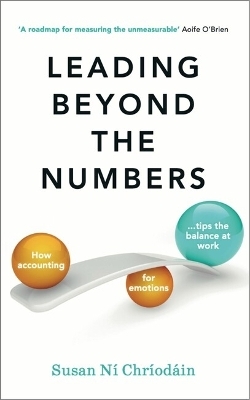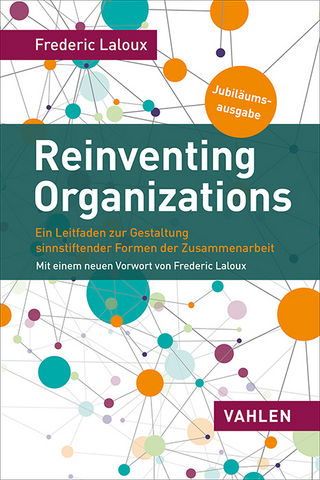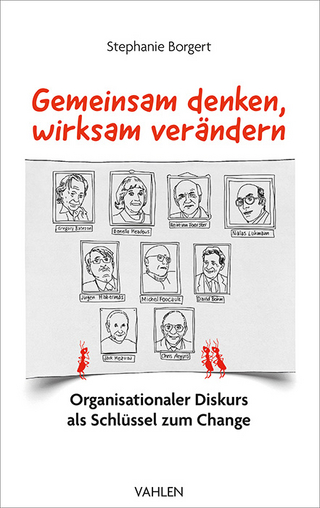
Leading Beyond the Numbers
Practical Inspiration Publishing (Verlag)
978-1-78860-586-1 (ISBN)
Emotions at work: irrational, or invaluable?
For centuries we have divided mind and body, valuing reason over emotion. But new research is fundamentally changing our understanding about how our brains and bodies work. What might be possible when we leverage both our reason AND emotion?
Explore the vital link between emotions and organizational performance. Knowing more about our body and brain and how we are interconnected and interrelated can positively impact people, performance and profit.
Leadership coach and experienced finance director Susan Ní Chríodáin sits at the nexus of business and emotion and reveals how to reintroduce humanity into the workplace, for improved engagement and fulfillment, benefiting both individuals and organizations.
Susan Ní Chríodáin founded Beyond the Numbers to create more emotionally aware workplaces. She is an award-winning chartered accountant with a Big 4 background and her career has spanned three continents and a range of leadership roles. She hosts the popular podcast, Life Beyond the Numbers.
Foreword by Matt Phelan, co-founder The Happiness Index and author of Freedom to be Happy: the business case for happiness and The Happiness Index: why today’s emotions equal tomorrow’s business success.
Introduction
For centuries a battle has raged between emotion and reason, leading us to value thinking over feeling and mind over body. For many of us that has resulted in us relying on and developing our cognitive intelligence whilst diminishing our capacity to access and develop our other forms of intelligence. It isn’t our fault; we were conditioned that way. Until as recently as the 1980s emotions were viewed by scientists as insignificant – merely a nuisance or noise – and best ignored. Recent scientific developments challenge conventional thinking on the intelligence of our bodies including how emotions are made, what the primary role of emotion is and, most importantly for the workplace, how emotions influence our performance and profitability.
Part 1: Why account for emotions?
1: A growing (or going) concern?
According to a 2022 Gallup Report approximately only 1 in every 5 people feel engaged at work. Many of our workplaces are not conducive to people contributing their best and this has an impact on the bottom line. Our productivity is largely driven by how we feel about ourselves, our work, our colleagues and our organizations. The more we understand about how to draw the best from people, the more willing we will be to create cultures that value interpersonal collaboration. Leaving emotions out of the workplace equation has resulted in an epidemic of disengagement, mistrust and conflict. We are all emotional beings, and it’s time to invest in accounting for emotions at work rather than counting the mounting costs of ignoring them. Bringing emotions in requires more than just talk.
2: Back to Basics
The critical elements of each business are people and money. Accounting is a simple, yet elegant, way of conveying a version of the story of the financial health and performance of a business. To the external world this story is told through the medium of the annual financial statements. Each business is unique and even if their balance sheets are comparable the story beyond the numbers would differ. Have you ever thought about using a business balance sheet to account for your life?
Part 2: Human beings
3: Accounting for the brain at work
Technological advancements have opened up new frontiers in understanding how the human brain works and taken us beyond many of the popular assertions and beliefs. Explore how our brain works, how we make meaning and the implications of these at work with the help of recent developments in neuroscience, including neuroplasticity and research by Lisa Feldman Barrett on the predictive nature of our brain.
4: Accounting for the body at work
Our body is key to our performance, not just our brain. Discover the value of connecting more with your body at work. Do you know the differences between embodied self-awareness and conceptual self-awareness? Take an in-depth look at ‘body-budgeting’ a phrase used by Lisa Feldman Barrett to describe allostasis which helps the body adapt to changes in the environment. Our senses, breath, heart, gut, and the role of our nervous system helping us survive and thrive are also covered.
5: Reconciling brain, body and behavior
The traditional view of emotion was that emotions were automatic responses to specific circumstances. Neuroscience research has challenged this belief and come up with a new theory for how emotions are made. All humans are emotional beings. We don’t always connect what is going on in our body with the situation we are in, especially when faced with uncertainty or perceived threats. Also, our internal data, emotions and feelings, may not always be accurate or true. We don’t need to fear or feelings and by tuning into what is going on in our body and revaluing the data we can become more resourceful and distinguish between feeling unsafe or uncomfortable. Increasing our emotional vocabulary pays dividends. With a greater sense of self, we can self-regulate and move through complexity, difficulty, tension and uncertainty more confidently.
Part 3: Being human
6: I’m only human: not rational or emotional but rational and emotional
This chapter includes a selection of stories from my own life and the lives of Life Beyond the Numbers podcast guests. These stories help illustrate the concepts covered so far. Gain a greater understanding of the role our emotions play in our attention, creativity, decision-making, effectiveness, interactions, learning, performance, thinking and well-being. Reflect on the costs of either-or rather than both-and approaches.
7: Accounting for emotions
An adaptation of the financial statements, the balance sheet specifically, to present a view of how things like sleep, food, exercise, engagement levels, fear and stress impact individual performance. Each person impacts the performance of the organization so our cumulative physical, mental and emotional states can all have an impact on the bottom line. Our brain and body are always working to keep us in balance. There is beauty in balancing a set of financial statements. The intricacies that underpin the workings are wonderous. The real beauty is seeing people be their best selves. The intricacies that underpin our workings are wondrous too, and not one particular combination, input or formula will ever generate the same result. What is the on your performance at work? Prepare your own personal balance sheet by creating your unique formula:
How do you manage your energyflow?
Do you know how to value your intangibles – strengths, values?
What is the return on investment of maintaining an optimal level of health?
What is the impact of cumulative losses?
Are you trying to generate profit at any cost?
Part 4: Business sense & sensibility
8: Disintegration and dysregulation: regulation and integration
Organizational culture is a set of shared values, beliefs, attitudes and assumptions. It is a proxy for the emotional state of an organization, or the collective emotional states of people who work there. People in leadership positions exert influence over this. Emotional contagion is present at work as moods and feelings can synchronize, spread and impact performance. Our nervous systems are always communicating, and we can co-regulate. It’s our loss when we don’t acknowledge this on an organizational level. Do we keep quiet and carry on, ensure that the workplace is psychologically safe, or introduce new ways of working? And what is the impact on hybrid workplaces? Investing in inner development and strengthening social intelligence will enhance outer organizational growth, increase revenue and retention and decrease conflict, disengagement and mistrust.
9: Why doesn’t everyone just get along - who is accountable and who is responsible?
We don’t create feelings of belonging, respect or safety in our organizations by talking about them. We need to walk the talk. Start with you. The ability to self-regulate is the key to greater confidence and competence and building better relationships. And building better relationships at work is what counts. What are you like as a leader of people? Do you know how to collaborate with others effectively? What are you contributing to your working relationships? Do the people you work with feel safe, feel respected and feel a sense of belonging? By being more emotionally aware you can positively influence the emotional state, and the financial results, of your workplace.
The bottom line: It’s more than a feeling
Emotions guide what we do at work. By dismissing the most unique element of what makes us human as noise or interference we have failed to generate the best behaviors to enable better collaboration, creativity, decisions, performance, relationships, results and workplaces. We are all shaped by our experiences, but we can all reshape ourselves and our futures. Connecting mind and body and embedding a both-and approach pays dividends. Don’t settle for someone else’s account of what life is supposed to be like, write your own story. You are the only one who is accountable. The bottom line is that accounting for emotions tips the balance at work.
| Erscheinungsdatum | 10.04.2024 |
|---|---|
| Zusatzinfo | b/w sketches; 5 Illustrations |
| Verlagsort | Tadley |
| Sprache | englisch |
| Maße | 140 x 216 mm |
| Gewicht | 467 g |
| Themenwelt | Sachbuch/Ratgeber |
| Wirtschaft ► Betriebswirtschaft / Management ► Planung / Organisation | |
| Wirtschaft ► Betriebswirtschaft / Management ► Unternehmensführung / Management | |
| ISBN-10 | 1-78860-586-1 / 1788605861 |
| ISBN-13 | 978-1-78860-586-1 / 9781788605861 |
| Zustand | Neuware |
| Haben Sie eine Frage zum Produkt? |
aus dem Bereich


